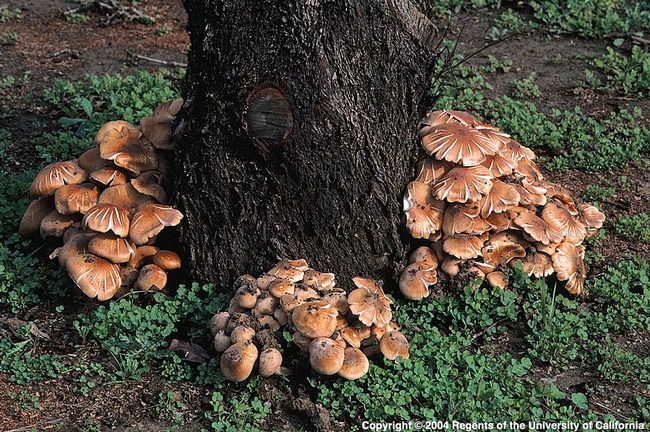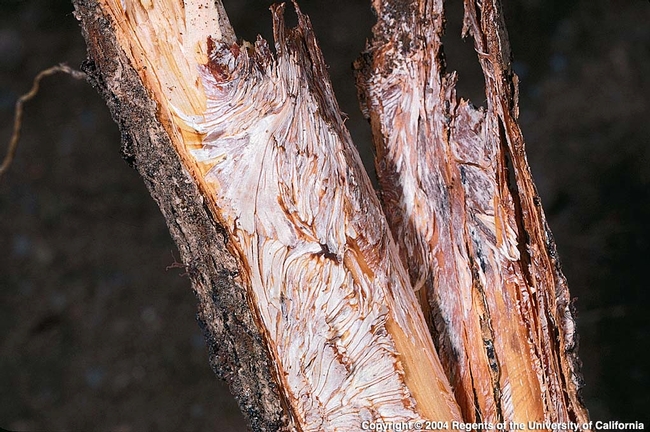There have been a lot of new avocado orchards planted during the last few years. These often have been in old ‘Valencia’ orchards or lemons that had poor production. In order to save money, growers have just cut the trees at ground level and replanted the avocados near the stumps. Avocados have recognition of being resistant to Armillaria, but in this environment of high disease pressure, they can fail.
Armillaria root rot is common, yet is an infrequently identified and poorly understood disease. It is capable of attacking most species of trees and other woody plants growing in California. It is sometimes called “shoestring root rot” and the causal fungus is often referred to as the “honey mushroom.” Because oak is one of the preferred hosts, it is also called “oak root fungus.”
If a tree undergoes a slow to rapid decline without any obvious reason, suspect Armillaria as the cause. Certain areas, such as drainage areas from chaparral or woodlands are likely areas for this disease. Old roots left underground provide a food base for continued fungal growth and survival.
General symptoms of Armillaria resemble those of other root disorders. These symptoms are disrupted growth, yellow foliage, branch dieback, and resin or gum exudates at the root collar. Trees may die rather abruptly without showing any decline symptoms. Avocados typically have a rather protracted death, but in citrus it can be rapid.
Only rarely can the disease be diagnosed without examining the larger buttress roots and root collar of the tree. After carefully removing the soil, examine for the presence of:
1) Rhizomorphs, or fungal ‘shoestrings’ attached to the wood under the bark. These may occur beneath the bark for some distance above the soil line in advanced cases, rarely they may radiate from the wood into the soil. Rhizomorphs may also grow out from the larger roots, resembling feeder roots in appearance. They are about the diameter of pencil lead and vary in color from black to reddish brown. The interior consists of white mycelial tissue.
2) Decayed areas of wood at the root collar or on the crown roots. Armillaria causes a white rot and the wood develops a stringy texture. Roots in advanced stages of decay may be soft, yellowish and wet.
3) Veined, white mycelial fans between the bark and wood where the cambium has been killed. Sometimes this fan (or fans) extends quite far above the soil line beneath the bark.
4) Soil remaining attached to the roots.
5) Characteristic mushrooms on the lower trunk or on the ground near the infected roots. These short-lived annual fruiting structures of the disease-causing fungus may develop during the fall or winter rainy season and may occur in small clusters or in large numbers. The stalk is typically yellow and 3 inches or more long. Usually a ring is connected to the stalk just below the cap. The cap is 2-5 inches across and often honey-yellow. It may be dotted with dark brown scales. The underside is covered with loosely spaced white or yellow gills radiating from the stem.
After the disease has been identified, the grower should study the situation to determine the role Armillaria root rot has played in causing the decline or death of the tree. Frequently the fungus is only involved in a secondary manner by invading and destroying roots after the tree has been exposed to stress of some form, such as severe drought, water logging, or soil fill over the roots. The fungus can also act as a saprophyte feeding on dead wood. It is frequently involved in the decay of old tree stumps and roots.
Many oaks are lightly infected with the disease for years with no resultant damage except for isolated pockets of buttress root rot which are walled off by the tree and have no ill effects. Other infected trees show no damage until subjected to stress. Accumulating evidence suggests the type of root exudate that is produced influences the susceptibility of the tree. Certain forms of stress cause a shift in exudates that promote rapid development of the fungus and may hasten tree invasion and decay.
Spores are produced by the mushroom fruiting structures (mushrooms) and disseminated by air currents and introduced into new area. Once the fungus enters the cambium and bark tissues, mycelial fans develop during the parasitic phase of the attack. Subsequently, mycelium invades and decays the woody tissue of the roots and sometimes also the base of the trunk. Under proper conditions the fruiting structures form at or near the base of the infected tree, completing the life cycle.
Direct control of the fungus in a diseased tree is not possible with present technology. However, in many instances the fungus is incapable of causing severe damage unless the tree is first subjected to substantial stress. Thus, keeping the tree healthy and avoiding severe stress is one important approach in preventing loss of trees to Armillaria.
Drought and leaf defoliation are two major forms of stress that favor Armillaria. In dry years it is advisable, as in all years, to make sure irrigation scheduling is appropriate. Stresses such as defoliation from persea mite, soil compaction and physical injury can exacerbate the disease. Nutrient management may minimize Armillaria effects, although little research information exists on this subject.
The second most important means of minimizing Armillaria damage is to avoid or eliminate the fungus inoculum before planting. Trees planted in former orchards will quite possibly be exposed. Since these sites cannot be avoided, here is a suggestion that will be helpful: remove stumps and old roots from the old orchard to the greatest extent possible.
Below:
Armillaria mushrooms and hyphal plaques under the bark
Attached Images:

